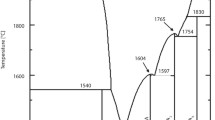Abstract
Technological and service characteristics of ceramic castables and low-cement refractory castables (LCRCs) are compared. Unlike LCRCs prepared from dry-ground powders, the ceramic castables contain a nanoparticle phase (5 – 100 nm), which to a significant extent determines their operational properties. The initial mechanical strength of ceramic binders can be increased substantially by adding water-soluble resins to their composition. A way toward developing oxide-carbon ceramic castables is outlined. Compositions for binding agents with enhanced high-temperature strength are developed.
Similar content being viewed by others
REFERENCES
Yu. E. Pivinskii, Refractories in the 21th Century [in Russian], BelGTASM Publishers, Belgorod (1999).
“Japanese refractory output 1997–2000, ” Industr. Minerals, April, 27 (2001).
T. Morimoto, “Unshaped refractories and their potential demand in the market, ” Taikabutsu Refractories, 34(12), 701–705 (1982).
Ch. Parr, C. Revais, N. Bunt, et al., “Aging a low cement castable, ” in: Proceedings of Unitecr-97, New Orleans (1997), pp. 81–90.
E. M. Grishpun, Yu. E. Pivinskii, E. V. Rozhkov, et al., “Production Technology and service of high-alumina ceramic castable. 1. Ramming mixtures based modified bauxite HCBS, ” Ogneup. Tekh. Keram., No. 3, 37–41 (2000).
Yu. E. Pivinskii, K. V. Timoshenko, A. V. Cherevatova, et al., “Materials based on highly concentrated ceramic binding suspensions (HCBS). Molding and strength of silica mixtures based on plasticized quartz sand HCBS, ” Ogneup. Tekh. Keram., No. 8, 7–10 (1999).
E. V. Rozhkov, Yu. E. Pivinskii, M. Z. Naginskii, et al., “Production and service of high-alumina castables. 2. Properties and service of vibration-placed castables based on bauxite-modified highly concentrated ceramic binding suspensions (HCBS) for use in blast-furnace runners, ” Ogneup. Tekh. Keram., No. 5, 37–44 (2001).
Yu. E. Pivinskii, Ceramic Binding Agents and Ceramic Castables [in Russian], Metallurgiya, Moscow (1990).
Yu. E. Pivinskii, A Technology for Manufacture and Industrial-Scale Testing of Thixotropic Vibration-Cast Mixtures (Ceramic Castables) in Steelmaking Units. Report to the All-Russia Institute for Refractory Materials [in Russian], Leningrad (1990).
Yu. E. Pivinskii, “Ceramic castables — the final stage in the evolution of low-cement refractory castables (Part 1), ” Ogneup. Tekh. Keram., No. 1, 11–15 (2000).
T. Schraven, “High wear resistant spinel ceramics for slide and purging systems, ” Pahage Feuerfeste Erzeugnisse (FRG), Prospectus (1998).
R. Krebs, “Modern solution of refractory problems with unshaped refractories, ” in: Proceedings of the Unified International Conference of Refractories: Unitecr-99, Berlin (1999), pp. 1–5.
P. Dyubrei and V. M. Solov'ev, “Andalusite—a promising material for the production of high-quality refractories, ” Ogneup. Tekh. Keram., No. 4, 24–30 (1999).
P. L. Mityakin and Yu. E. Pivinskii, “Properties of a quartzbased ceramic castable, ” Ogneupory, No. 9, 55–59 (1980).
V. A. Doroganov and Yu. E. Pivinskii, “Refractory plastic mixtures based on highly concentrated binding suspensions (HCBSs). Structural and mechanical properties of plasticized mixtures and materials based on bauxite HCBSs, ” Ogneup. Tekh. Keram., No. 4, 18–23 (2001).
G. S. Khodakov, Physics of Disintegration [in Russian], Nauka, Moscow (1972).
G. S. Khodakov, “Physicochemical mechanics of solid disintegration, ” Kolloid. Zh., 60(5), 684–698 (1998).
D. Van Harssel, J. O. Laureh, and A. Boor, “Synthetic raw materials — a key to advanced technologies in the production of refractories, ” in: Vestnik UGTU – UPI, No. 1: Proceedings of the International Conference “Physical Chemistry and Technology of Oxide-Silicate Materials” [in Russian], Ekaterinburg (2000), pp. 3–26.
Alcoa Refractory Raw Materials: Applications. An Alcoa Report to a Workshop Held at the Pervoural'skii Dinas Plant, February 16, 2000.
Yu. E. Pivinskii, F. S. Kaplan, S. G. Semikova, and M. A. Trubitsyn, “Highly concentrated ceramic binding suspensions. The colloid component and binding properties, ” Ogneupory, No. 2, 13–18 (1989).
B. D. Summ and N. I. Ivanova, “Objects and methods of colloid chemistry in nanochemistry, ” Usp. Khim., 69(11), 995–1008 (2000).
M. N. Rittner, “Ideas flow at fine, ultrafine and nanopowders' 99, ” Am. Ceram. Soc. Bull., No. 2, 64–67 (2000).
Yu. E. Pivinskii and M. A. Trubitsyn, “Highly concentrated ceramic binding suspensions. Dispersion medium, stabilization and binding properties, ” Ogneupory, No. 12, 9–14 (1987).
Yu. E. Pivinskii and A. G. Romashin, Quartz Ceramics [in Russian], Metallurgiya, Moscow (1974).
Yu. E. Pivinskii, “From quartz ceramics towards ceramic binders and ceramic castables, ” in: Proceedings of a Festive Research Conference Devoted to the 85th Anniversary of A. M. Prokhorov's Birth [in Russian], St. Petersburg State Technological Institute (Technical University), St. Petersburg (2001), pp. 148–153.
I. O. Elin and O. A. Tarakhtunov, Aminoplasts and Carbamide Plastics. Encyclopedia of Polymers. Vol. 1 [in Russian], Sovetskaya Éntsiklopediya, Moscow (1972), pp. 110–116.
B. B. Gulyaev, P. A. Kornyushkin, and A. V. Kuzin, Molding Processes [in Russian], Mashinostroenie, Leningrad (1987).
L. M. Khananashvili and K. A. Andrianov, Technology of Organoelemental Monomers and Polymers [in Russian], Khimiya, Moscow (1983).
I. D. Kashcheev, Oxide-Carbon Refractories [in Russian], Intermet Engineering, Moscow (2000).
A. Petzold and I. Ulbricht, Feuerbeton and Betonartige Feuerfeste Massen und Materialien, Deutscher Verlag für Grundstoff-Industrie, Leipzig, Stuttgart (1994).
Yu. E. Pivinskii, “Structural ceramics: technology and problems, ” in: Chemistry and Technology of Silicate and High-Melting Nonmetallic Materials [in Russian], Nauka, Leningrad (1989), pp. 109–125.
Author information
Authors and Affiliations
Rights and permissions
About this article
Cite this article
Pivinskii, Y.E., Rozhkov, E.V. Ceramic Castables — Final Stage in the Evolution of Low-Cement Refractory Castables. Part 3. Refractories and Industrial Ceramics 44, 134–140 (2003). https://doi.org/10.1023/A:1026391915300
Issue Date:
DOI: https://doi.org/10.1023/A:1026391915300




